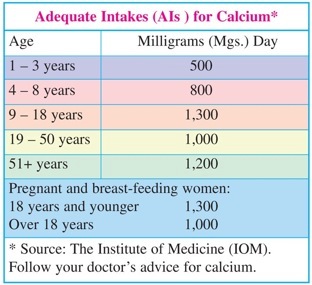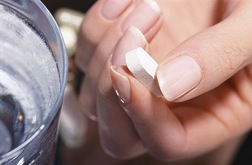-
Muscle & Bone Problems








Osteoporosis
Osteoporosis is a loss in bone mass and bone strength. Bones become weak and brittle. This makes them more prone to fractures. Any bone can be affected. The hips, wrists, and spine are the most common sites.
Signs & Symptoms
Osteoporosis is a “silent disease.” It can occur without seeing changes taking place inside the body. Often the first sign is a fracture of the hip, wrist, or spine. When signs and symptoms occur, they include:
-
•Gradual loss of height.
-
•Rounding of the shoulders.
-
•Sudden back pain.
-
•Stooped posture.
-
•Dowager’s hump.
Osteoporosis is more common in women than men.
Follow your doctor’s advice about taking calcium and vitamin D supplements.








Causes
The actual causes are not known. Risk factors include:
-
•Being female. Women are 4 times more likely to develop osteoporosis than men. Why? Their bones are thinner and lighter. They also have rapid bone loss at menopause. This is due to a sharp decline in estrogen.
-
•Having a thin, small-framed body.
-
•Being Caucasian or Asian. African Americans and Hispanic Americans are at risk, too.
-
•Lack of physical activity, especially weight-bearing exercises, such as walking.
-
•Exercising too much to the point where menstrual periods cease.
-
•Lack of calcium and vitamin D.
-
•Family history of the disease.
-
•Smoking cigarettes.
-
•Alcoholism, which may damage bones. Heavy drinkers often eat poorly, too. They are also more prone to fractures from falls.
-
•Taking certain medicines for a long time. Examples are corticosteroids and antacids with aluminum.
-
•Some disorders, such as hyperthyroidism.
-
•Chronic diseases that affect the intestines, kidneys, and lungs and alter hormone levels.
-
•Early menopause. This can occur naturally or after surgery that removes both ovaries.

Treatment
There is no cure. The focus of treatment is to:
-
•Prevent the disease.
-
•Prevent further bone loss.
-
•Build new bone.
Special X-rays, such as one known as DEXA, can measure bone mass in different places of the body. These tests are safe and painless. They help doctors decide if and what kind of treatment is needed. This includes:
-
•Treating medical problems that increase the risk for osteoporosis.
-
•Medications. There are different kinds. Your doctor will prescribe one(s) best suited for your needs.
-
•Exercises as advised by your doctor.
-
•Proper posture.
-
•A balanced diet with enough calcium and vitamin D.
-
•Calcium and vitamin D supplements.
-
•Fall prevention measures.
Self-Care / Prevention
To Treat Osteoporosis
-
•Take medicines, as prescribed.
-
•Eat a balanced diet. Get your recommended Adequate Intake (AI) for calcium every day.
After a fall, are you not able to get up or do you have wrist, hip, or back pain?
Do you have signs of osteoporosis listed above? Do you want to find out about medicines to prevent and/or treat osteoporosis?
Are you a female age 65 or older and have you not had a bone mineral density test?
Are you a female between ages 60 and 65, do you have risk factors for osteoporosis listed above, and have you not had a bone mineral density test?
Questions to Ask
-
•Choose high-calcium foods daily:
-
-Skim and low-fat milks, yogurts, and cheeses. {Note: If you are lactose intolerant, see information for “Lactose Intolerance.”}
-
-Soy milks and yogurts with added calcium.
-
-Soft-boned fish and shellfish, such as salmon, sardines, or shrimp.
-
-Broccoli, kale, and collard greens.
-
-Beans and bean sprouts, as well as, tofu (soybean curd), if processed with calcium.
-
-Calcium-fortified foods, such as some juices and ready-to-eat cereals.
-
•Take calcium supplements, as advised by your doctor.
-
•Get vitamin D from: Sunshine (15 minutes of midday sunshine may meet daily needs) and from foods. These include fortified milks and cereals, egg yolks, saltwater fish, liver, and cod liver oil. Take vitamin D supplements, as advised by your doctor.
-
•Do regular, weight-bearing exercise, such as walking, at least 3 or 4 times a week. A person with osteoporosis should exercise as advised by his or her doctor. Practice good posture.
-
•Don’t smoke. Limit alcohol.
-
•Use fall prevention measures:
-
-Ask your doctor if any medications you take could cause you to fall and how to deal with this.
-
-Use grab bars and safety mats in your tub and shower. Use handrails on stairways.
-
-Pick things up by bending your knees and keeping your back straight. Don’t stoop.
-
-Wear flat, sturdy, nonskid shoes.
-
-If you use throw rugs, use ones with nonskid backs.
-
-Use a cane or walker, if necessary.
-
-Keep halls, stairways, and entrances well lit. Use night lights in hallways, bathrooms, etc.




Get more information from:
HealthyLearn® | www.HealthyLearn.com. Click on MedlinePlus®.
National Osteoporosis Foundation | 202.223.2226 | www.nof.org
Osteoporosis and Related Bone Disease National Resource Center | 800.624.BONE (624.2663) | www.osteo.org




Copyright © 2009, American Institute for Preventive Medicine. All rights reserved.